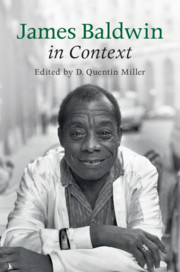Book contents
- James Baldwin in Context
- James Baldwin in Context
- Copyright page
- Contents
- Contributors
- Introduction: James Baldwin in Context
- Part 1 Life and Afterlife
- Chapter 1 Harlem During and After the Renaissance
- Chapter 2 American Writers in Paris
- Chapter 3 Greenwich Village and Emerging Bohemianism
- Chapter 4 1963: Baldwin’s Annus Mirabilis
- Chapter 5 East Meets West: Baldwin in Istanbul in the 1960s
- Chapter 6 Baldwin as Teacher
- Chapter 7 A Long Way from Home: Baldwin in Provence
- Chapter 8 Decline of Reputation in the 1980s
- Chapter 9 The Critical Renaissance: 1999–Present
- Chapter 10 Biographies
- Chapter 11 The Matter of Black Lives: Baldwin Today
- Part 2 Social and Cultural Contexts
- Part 3 Literary Contexts
- Index
Chapter 10 - Biographies
from Part 1 - Life and Afterlife
Published online by Cambridge University Press: 12 July 2019
- James Baldwin in Context
- James Baldwin in Context
- Copyright page
- Contents
- Contributors
- Introduction: James Baldwin in Context
- Part 1 Life and Afterlife
- Chapter 1 Harlem During and After the Renaissance
- Chapter 2 American Writers in Paris
- Chapter 3 Greenwich Village and Emerging Bohemianism
- Chapter 4 1963: Baldwin’s Annus Mirabilis
- Chapter 5 East Meets West: Baldwin in Istanbul in the 1960s
- Chapter 6 Baldwin as Teacher
- Chapter 7 A Long Way from Home: Baldwin in Provence
- Chapter 8 Decline of Reputation in the 1980s
- Chapter 9 The Critical Renaissance: 1999–Present
- Chapter 10 Biographies
- Chapter 11 The Matter of Black Lives: Baldwin Today
- Part 2 Social and Cultural Contexts
- Part 3 Literary Contexts
- Index
Summary
“One writes out of one thing only: one’s own experience.” This pronouncement, from Baldwin’s “Autobiographical Notes” (1955), told his early readers what they already knew: that his work was closely aligned with his life. That conclusion may be too simplistic in Baldwin’s case, though. His life, like his writing, was surprising, difficult to grasp, not always coherent (in the traditional sense of the word), and far from straightforward. His first novel, Go Tell It on the Mountain (1953), was a bildungsroman (albeit an unconventional one that ranged far into the imagined lives of the protagonist’s parents and aunt) and his most memorable essays from his first collection – “Notes of a Native Son” (1955) and “Stranger in the Village” (1953) – filled in crucial details from the author’s life. Although later novels and short stories were about characters who were clearly not Baldwin – a bisexual white man from a privileged background, a pregnant teen girl, a racist white southern sheriff, a heroin-using jazz pianist – and although his essays were sometimes more journalistic than confessional, Baldwin’s own life (including his imagination and his observation, not just his experiences) was often his subject, and his readers responded favorably when he shared his life’s details. At the same time, he was sometimes coy about the way he engaged his life in his work. Even the word “one” in the quotation above – a recurrent pronoun in his early essays – demonstrates his occasional reluctance to reveal himself in full. Baldwin revealed himself in glimpses only. He left it to others to tell his entire story.
- Type
- Chapter
- Information
- James Baldwin in Context , pp. 105 - 116Publisher: Cambridge University PressPrint publication year: 2019



